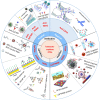Nanomaterial-Based Immunocapture Platforms for the Recognition, Isolation, and Detection of Circulating Tumor Cells
- PMID: 35360401
- PMCID: PMC8964261
- DOI: 10.3389/fbioe.2022.850241
Nanomaterial-Based Immunocapture Platforms for the Recognition, Isolation, and Detection of Circulating Tumor Cells
Abstract
Circulating tumor cells (CTCs) are a type of cancer cells that circulate in the peripheral blood after breaking away from solid tumors and are essential for the establishment of distant metastasis. Up to 90% of cancer-related deaths are caused by metastatic cancer. As a new type of liquid biopsy, detecting and analyzing CTCs will provide insightful information for cancer diagnosis, especially the in-time disease status, which would avoid some flaws and limitations of invasive tissue biopsy. However, due to the extremely low levels of CTCs among a large number of hematologic cells, choosing immunocapture platforms for CTC detection and isolation will achieve good performance with high purity, selectivity, and viability. These properties are directly associated with precise downstream analysis of CTC profiling. Recently, inspired by the nanoscale interactions of cells in the tissue microenvironment, platforms based on nanomaterials have been widely explored to efficiently enrich and sensitively detect CTCs. In this review, various immunocapture platforms based on different nanomaterials for efficient isolation and sensitive detection of CTCs are outlined and discussed. First, the design principles of immunoaffinity nanomaterials are introduced in detail. Second, the immunocapture and release of platforms based on nanomaterials ranging from nanoparticles, nanostructured substrates, and immunoaffinity microfluidic chips are summarized. Third, recent advances in single-cell release and analysis of CTCs are introduced. Finally, some perspectives and challenges are provided in future trends of CTC studies.
Keywords: biological detection; circulating tumor cells; immunocapture platform; liquid biopsy; nanomaterials.
Copyright © 2022 Liu, Li, Zhang and Guo.
Conflict of interest statement
The authors declare that the research was conducted in the absence of any commercial or financial relationships that could be construed as a potential conflict of interest.
Figures











Similar articles
-
Nanostructure embedded microchips for detection, isolation, and characterization of circulating tumor cells.Acc Chem Res. 2014 Oct 21;47(10):2941-50. doi: 10.1021/ar5001617. Epub 2014 Aug 11. Acc Chem Res. 2014. PMID: 25111636 Free PMC article. Review.
-
Nanotechnology-Assisted Isolation and Analysis of Circulating Tumor Cells on Microfluidic Devices.Micromachines (Basel). 2020 Aug 14;11(8):774. doi: 10.3390/mi11080774. Micromachines (Basel). 2020. PMID: 32823926 Free PMC article. Review.
-
NanoVelcro rare-cell assays for detection and characterization of circulating tumor cells.Adv Drug Deliv Rev. 2018 Feb 1;125:78-93. doi: 10.1016/j.addr.2018.03.006. Epub 2018 Mar 15. Adv Drug Deliv Rev. 2018. PMID: 29551650 Free PMC article. Review.
-
Enrichment and single-cell analysis of circulating tumor cells.Chem Sci. 2017 Mar 1;8(3):1736-1751. doi: 10.1039/c6sc04671a. Epub 2016 Dec 7. Chem Sci. 2017. PMID: 28451298 Free PMC article.
-
Nanomaterial-based Microfluidic Chips for the Capture and Detection of Circulating Tumor Cells.Nanotheranostics. 2017 Aug 20;1(4):389-402. doi: 10.7150/ntno.21268. eCollection 2017. Nanotheranostics. 2017. PMID: 29071201 Free PMC article. Review.
Cited by
-
Liquid Biopsy in Cancer: Focus on Lymphoproliferative Disorders.Cancers (Basel). 2022 Oct 31;14(21):5378. doi: 10.3390/cancers14215378. Cancers (Basel). 2022. PMID: 36358796 Free PMC article. Review.
-
Recent Advances in Methods for Circulating Tumor Cell Detection.Int J Mol Sci. 2023 Feb 15;24(4):3902. doi: 10.3390/ijms24043902. Int J Mol Sci. 2023. PMID: 36835311 Free PMC article. Review.
-
Circulating Exosome Cargoes Contain Functionally Diverse Cancer Biomarkers: From Biogenesis and Function to Purification and Potential Translational Utility.Cancers (Basel). 2022 Jul 10;14(14):3350. doi: 10.3390/cancers14143350. Cancers (Basel). 2022. PMID: 35884411 Free PMC article. Review.
-
Preparation and PET/CT imaging of implant directed 68Ga-labeled magnetic nanoporous silica nanoparticles.J Nanobiotechnology. 2023 Aug 17;21(1):270. doi: 10.1186/s12951-023-02041-8. J Nanobiotechnology. 2023. PMID: 37592318 Free PMC article.
-
Nanomaterials in gastric cancer: pioneering precision medicine for diagnosis, therapy, and prevention.Med Oncol. 2025 Mar 6;42(4):93. doi: 10.1007/s12032-025-02650-3. Med Oncol. 2025. PMID: 40050498 Review.
References
-
- Ashworth T. (1869). A Case of Cancer in Which Cells Similar to Those in the Tumours Were Seen in the Blood after Death. Aust. Med. J. 14, 146.
Publication types
LinkOut - more resources
Full Text Sources
Research Materials

